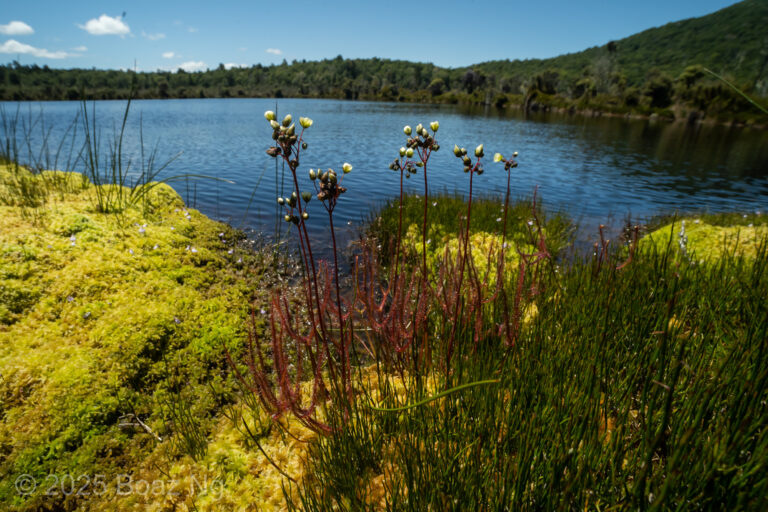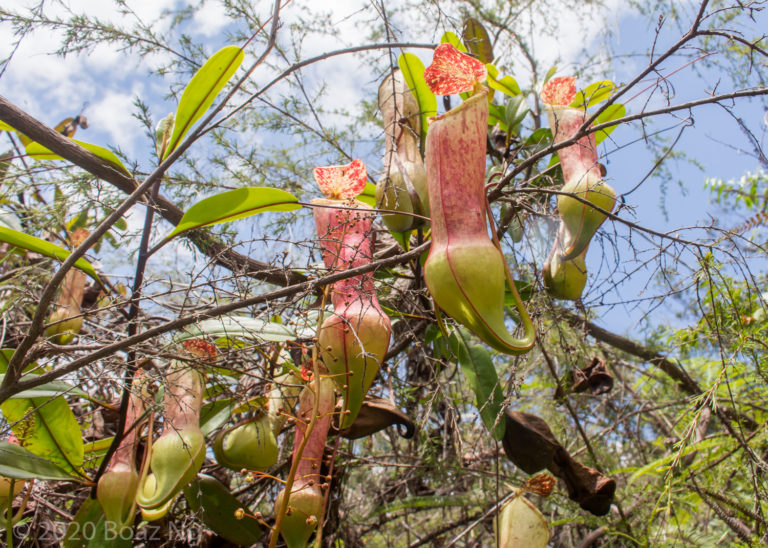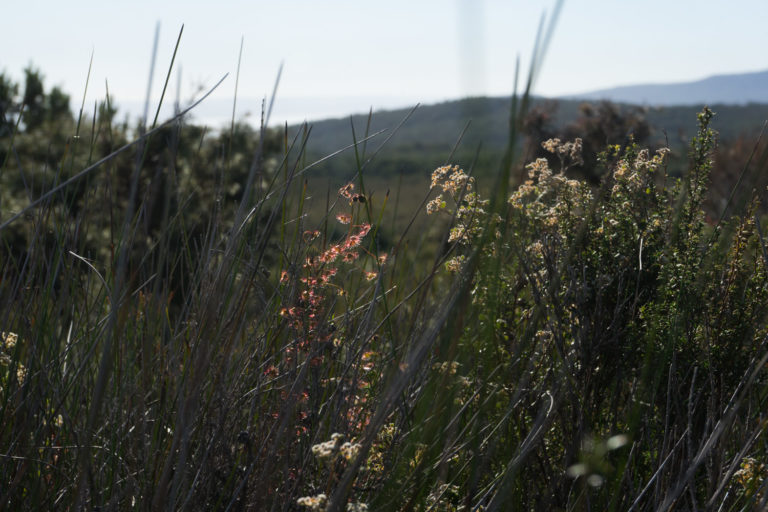Gunung Talang
West Sumatra is known for its chain of volcanic peaks, each dramatically rising high out of the lowlands. These conditions are perfect to induce speciation in Nepenthes – each region seems to have its own endemic species that only grow on the peaks of the area.
My first stop was a volcano called Gunung Talang. I had visited this region on my last stop over in Sumatra, but was unfortunately prevented to climb it by the oppressive tropical rain. This mountain is well known for its endemic species Nepenthes talangensis as well as the strange peristomeless Nepenthes inermis. Will my journey this time be more successful?
 The climb to the top is fairly straight forward, progressing quickly from tea plantation to deep highland rainforest to stunted cloud forest. However, as for Gunung Kerinci, its local popularity meant that the trail was heavily degraded and unfortunately devoid of Nepenthes. Perhaps I would have better luck surveying at the summit plateau? As I approached the top, thunderous clouds suddenly enveloped us and unleashed a torrent of rain. Nonetheless I spent a good hour bashing through the Pandanus and stunted bushes to try and sight some of these plants that I had climbed a whole mountain for. Alas, the thick fog obscured any trace of Nepenthes that day and I returned from the mountain soaking wet and miserable. Oh well, third time lucky?
Batang Palupuh
My gloom was quickly eclipsed by excitement as I learned that two _Rafflesia arnoldii _blooms had been located in Batang Palupuh Nature Reserve near the regional tourist center of Bukittinggi. Whilst not carnivorous, these parasitic plants emerge from its host vine to form the largest bloom in the world – reaching over 1 m in diameter. We met our local guide, a villager who searches deep into the rainforest to find these blooms, and with intrepid excitement set out into the virgin rainforest. After a short walk through the sticky jungle (sometimes the flowers can be located 2 hours away) we sighted the flowers. Perched on the side of a steep gully above a waterfall were two beautiful gigantic Rafflesia blooms.
The climb to the top is fairly straight forward, progressing quickly from tea plantation to deep highland rainforest to stunted cloud forest. However, as for Gunung Kerinci, its local popularity meant that the trail was heavily degraded and unfortunately devoid of Nepenthes. Perhaps I would have better luck surveying at the summit plateau? As I approached the top, thunderous clouds suddenly enveloped us and unleashed a torrent of rain. Nonetheless I spent a good hour bashing through the Pandanus and stunted bushes to try and sight some of these plants that I had climbed a whole mountain for. Alas, the thick fog obscured any trace of Nepenthes that day and I returned from the mountain soaking wet and miserable. Oh well, third time lucky?
Batang Palupuh
My gloom was quickly eclipsed by excitement as I learned that two _Rafflesia arnoldii _blooms had been located in Batang Palupuh Nature Reserve near the regional tourist center of Bukittinggi. Whilst not carnivorous, these parasitic plants emerge from its host vine to form the largest bloom in the world – reaching over 1 m in diameter. We met our local guide, a villager who searches deep into the rainforest to find these blooms, and with intrepid excitement set out into the virgin rainforest. After a short walk through the sticky jungle (sometimes the flowers can be located 2 hours away) we sighted the flowers. Perched on the side of a steep gully above a waterfall were two beautiful gigantic Rafflesia blooms.
 I had always assumed that I when I finally saw these plants, that they would be hidden behind a fence to prevent touchy tourists like me accidentally damaging them. But luckily for me I was in somewhat unregulated Indonesia and I quickly jumped at the opportunity to get up close and personal with them. The flowers are well known for their stench, which I found to be greatly exaggerated by popular science journalists who have never actually smelled it. For the molecular biologists out there, the scent can accurately be described as a faint waft of TEMED (imagine a perfume of ammonia and sulfur). This scent was enough to attract a hoard of flies which serve as the plants pollinator.
The texture of the leaves is dry and rubbery like a yoga mat. Intricate patterns of dots line the entire plant. In the end I spent so much time harassing the flowers and playing photoshoot that the local guide got bored and left.
I had always assumed that I when I finally saw these plants, that they would be hidden behind a fence to prevent touchy tourists like me accidentally damaging them. But luckily for me I was in somewhat unregulated Indonesia and I quickly jumped at the opportunity to get up close and personal with them. The flowers are well known for their stench, which I found to be greatly exaggerated by popular science journalists who have never actually smelled it. For the molecular biologists out there, the scent can accurately be described as a faint waft of TEMED (imagine a perfume of ammonia and sulfur). This scent was enough to attract a hoard of flies which serve as the plants pollinator.
The texture of the leaves is dry and rubbery like a yoga mat. Intricate patterns of dots line the entire plant. In the end I spent so much time harassing the flowers and playing photoshoot that the local guide got bored and left.
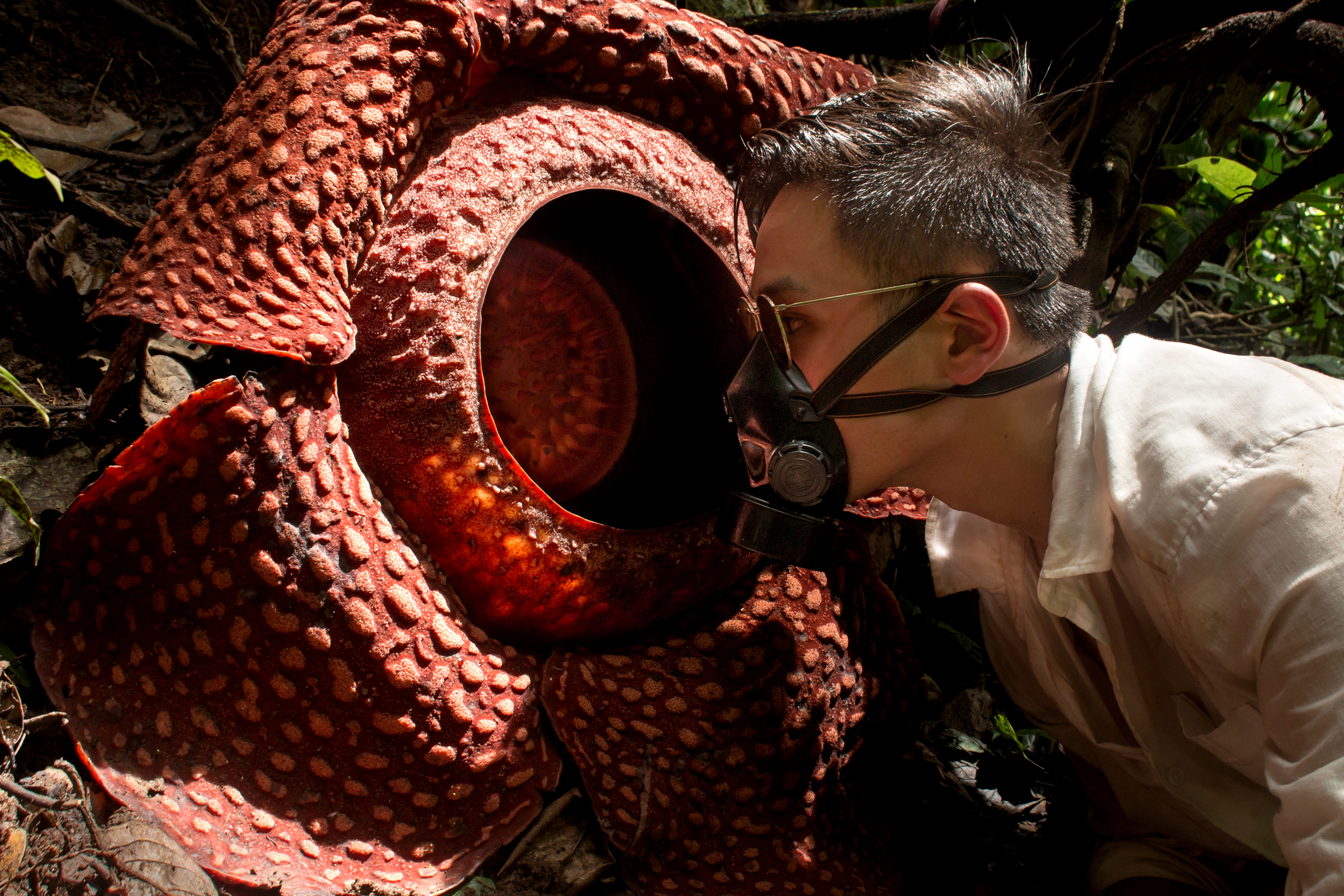 Having checked off another species on my plant bucket list, I skipped elatedly back to town to wash the dirt off my body. On the way back I spotted what appears to be Nepenthes reinwardtiana hanging high off the cliffs above the rice paddies. Overall, it was an extremely rewarding day!
Harau Valley
An hour or so away from Bukittinggi is a scenic region known as the Harau Valley. Here, steep sandstone cliffs rise abruptly out of the lowland rice paddies to form one of the most beautiful regions of West Sumatra. Moderated by the cold mountainous air towards the west and the hot drafts of the Riau plains, the area has a pleasant climate that supports an accessible host of lowland Nepenthes species. Whilst the valley flats have long been cleared for agriculture, the sandstone plateaus provide an (almost) inaccessible sanctuary for many lowland species. I stayed at the famous tourist abode, Abdi Homestay, where the owner connected me with his father – a champion of conservation and plant enthusiast himself.
Having checked off another species on my plant bucket list, I skipped elatedly back to town to wash the dirt off my body. On the way back I spotted what appears to be Nepenthes reinwardtiana hanging high off the cliffs above the rice paddies. Overall, it was an extremely rewarding day!
Harau Valley
An hour or so away from Bukittinggi is a scenic region known as the Harau Valley. Here, steep sandstone cliffs rise abruptly out of the lowland rice paddies to form one of the most beautiful regions of West Sumatra. Moderated by the cold mountainous air towards the west and the hot drafts of the Riau plains, the area has a pleasant climate that supports an accessible host of lowland Nepenthes species. Whilst the valley flats have long been cleared for agriculture, the sandstone plateaus provide an (almost) inaccessible sanctuary for many lowland species. I stayed at the famous tourist abode, Abdi Homestay, where the owner connected me with his father – a champion of conservation and plant enthusiast himself.
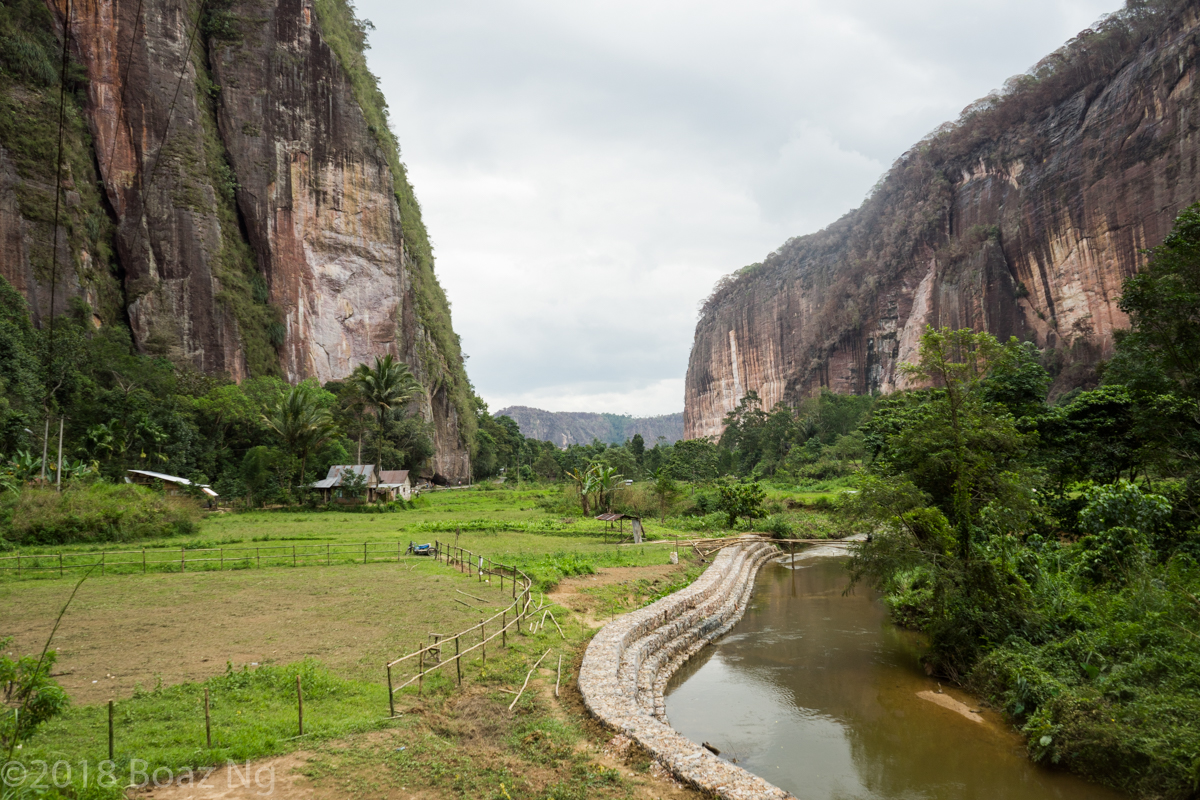 The next day we set off to climb these cliffs. My guide led me up a gully carved over thousands of years by water and the only way to reach the top of these cliffs. After slipping endless times over the mud and smooth rock (how the locals navigate these areas only in flip-flops amazes me), we finally reached the source of the water. As the gully narrowed into a deep chasm I suddenly realised that I was surrounded by the most beautiful botanical sight that I had ever seen!
The next day we set off to climb these cliffs. My guide led me up a gully carved over thousands of years by water and the only way to reach the top of these cliffs. After slipping endless times over the mud and smooth rock (how the locals navigate these areas only in flip-flops amazes me), we finally reached the source of the water. As the gully narrowed into a deep chasm I suddenly realised that I was surrounded by the most beautiful botanical sight that I had ever seen!
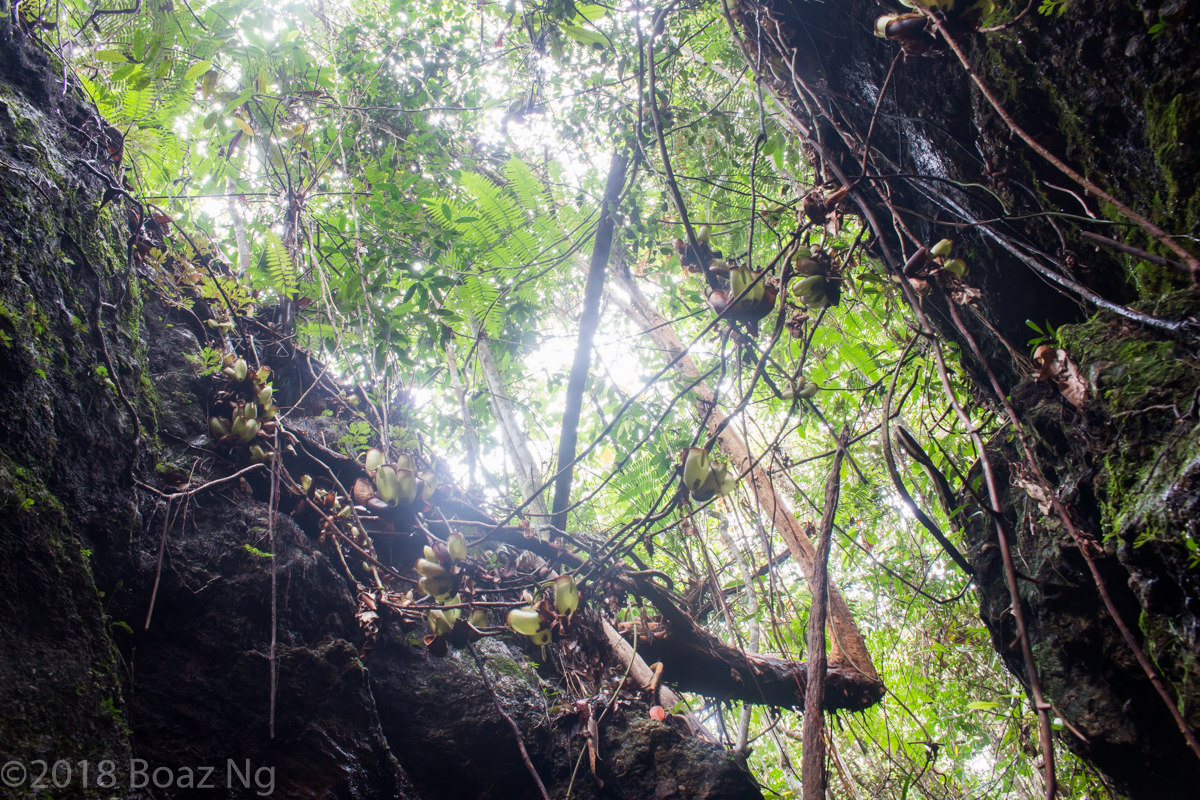 Around me were swathes of Nepenthes ampullaria vines hanging down and across the gully. Each vine sprouted thousands of beautiful lime green pitchers, each rimmed with a bright red peristome. It was as if I entered a house of mirrors with an endless sea of pitchers engulfing me.
Around me were swathes of Nepenthes ampullaria vines hanging down and across the gully. Each vine sprouted thousands of beautiful lime green pitchers, each rimmed with a bright red peristome. It was as if I entered a house of mirrors with an endless sea of pitchers engulfing me.
 After spending ages admiring the site, my patient guide moved me onward. I was surprised to find that the top of the sandstone cliffs were vast habitats complete with fields, streams and rainforest. As we trekked deeper into the jungle, the ground started getting wetter and wetter until it turned into a rainforest swamp. This habitat is characterised by saturated soils, a shaded canopy and of course, Nepenthes ampullariaand Nepenthes gracilis!
After spending ages admiring the site, my patient guide moved me onward. I was surprised to find that the top of the sandstone cliffs were vast habitats complete with fields, streams and rainforest. As we trekked deeper into the jungle, the ground started getting wetter and wetter until it turned into a rainforest swamp. This habitat is characterised by saturated soils, a shaded canopy and of course, Nepenthes ampullariaand Nepenthes gracilis!
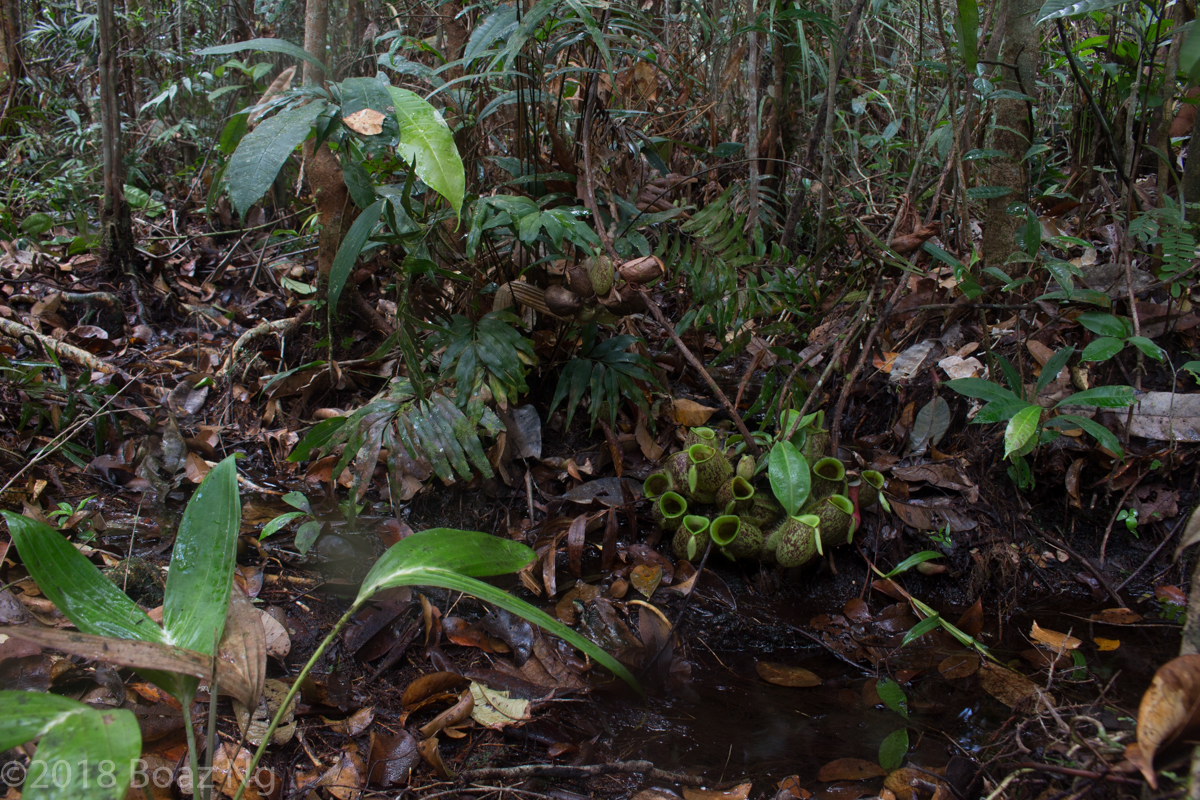 Indeed, the entire swamp was covered in these two species. Massive vines reached high into the canopy whilst basal rosettes littered the forest floor. The Nepenthes ampullaria in this area was different to the gully habitat – they were quite large, finely speckled with a green peristome. This species is known for its peculiar habit of rarely forming upper pitchers. Rather, rosettes of basal growth regularly sprout along the thick vines.
Indeed, the entire swamp was covered in these two species. Massive vines reached high into the canopy whilst basal rosettes littered the forest floor. The Nepenthes ampullaria in this area was different to the gully habitat – they were quite large, finely speckled with a green peristome. This species is known for its peculiar habit of rarely forming upper pitchers. Rather, rosettes of basal growth regularly sprout along the thick vines.
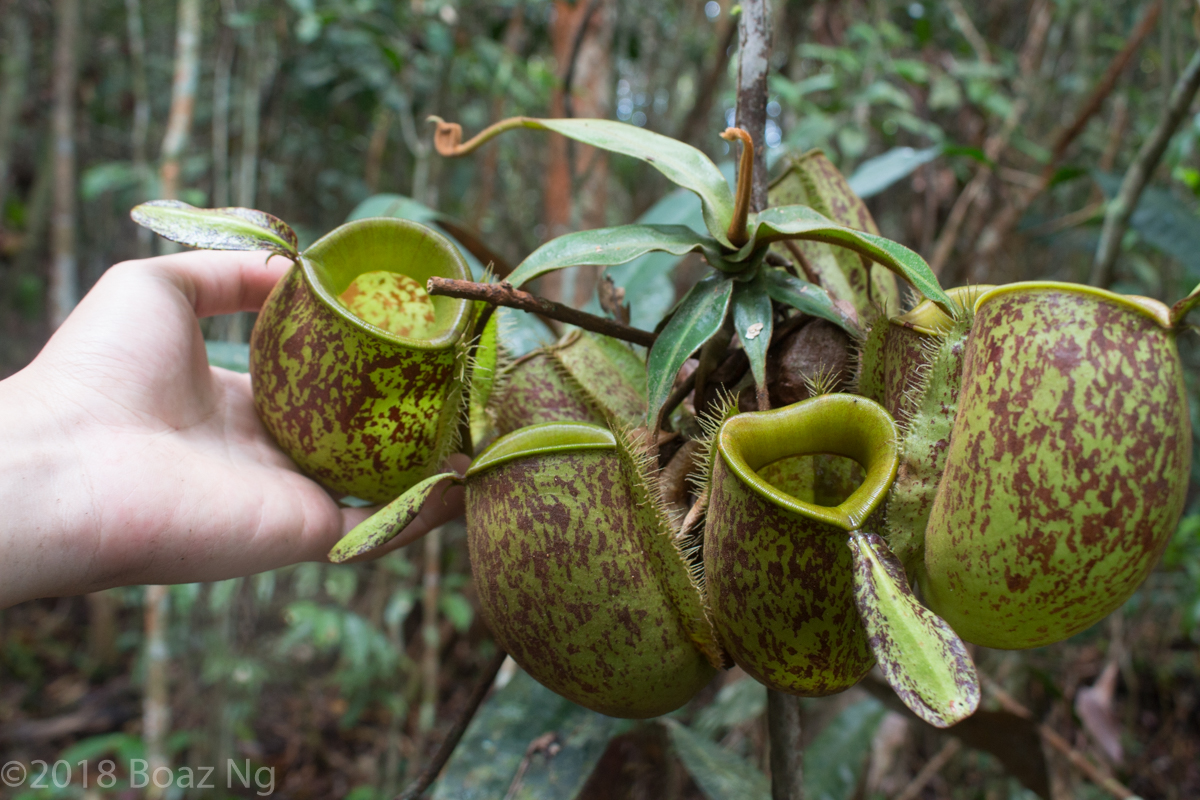 Its cousin Nepenthes gracilis shares amazingly similar growth habits. Both species prefer swampy undergrowth, are often sympatric with each other, form tight rosettes of basal pitchers and can send vines high above. What’s different is their trapping adaptations. Whilst the open pitchers of Nepenthes ampullaria are designed to trap leaf litter (earning them a detritivorous reputation), the elongated shape of Nepenthes gracilis is adapted for trapping ants. In the frequent tropical storms, ants shelter below the lid of the pitchers. A falling raindrop hits the lid from above, knocking the ant into digestive soup below.
Its cousin Nepenthes gracilis shares amazingly similar growth habits. Both species prefer swampy undergrowth, are often sympatric with each other, form tight rosettes of basal pitchers and can send vines high above. What’s different is their trapping adaptations. Whilst the open pitchers of Nepenthes ampullaria are designed to trap leaf litter (earning them a detritivorous reputation), the elongated shape of Nepenthes gracilis is adapted for trapping ants. In the frequent tropical storms, ants shelter below the lid of the pitchers. A falling raindrop hits the lid from above, knocking the ant into digestive soup below.
 Moving on from the mosquito infested rainforest depression (DEET becomes your best friend in tropical Asia) we exited to find ourselves in the exposed hills that perch above the edge of the cliffs. The habitat change is sudden – on my right was a thick impenetrable wall of rainforest growth, on my left was dry and dull scrub of almost Mediterranean quality. Adapted to the sunny sandstone substrates were the lovely Nepenthes eustachya and Nepenthes albomarginata.
The pitchers of the endemic Nepenthes eustachya have a bulbous base that tapers abruptly into a cylindrical neck. They are messily coloured, transitioning from green to pink to white with splotches of red on the lid. The species form thick vines that blanket the surrounding vegetation to get as much light as possible.
Moving on from the mosquito infested rainforest depression (DEET becomes your best friend in tropical Asia) we exited to find ourselves in the exposed hills that perch above the edge of the cliffs. The habitat change is sudden – on my right was a thick impenetrable wall of rainforest growth, on my left was dry and dull scrub of almost Mediterranean quality. Adapted to the sunny sandstone substrates were the lovely Nepenthes eustachya and Nepenthes albomarginata.
The pitchers of the endemic Nepenthes eustachya have a bulbous base that tapers abruptly into a cylindrical neck. They are messily coloured, transitioning from green to pink to white with splotches of red on the lid. The species form thick vines that blanket the surrounding vegetation to get as much light as possible.
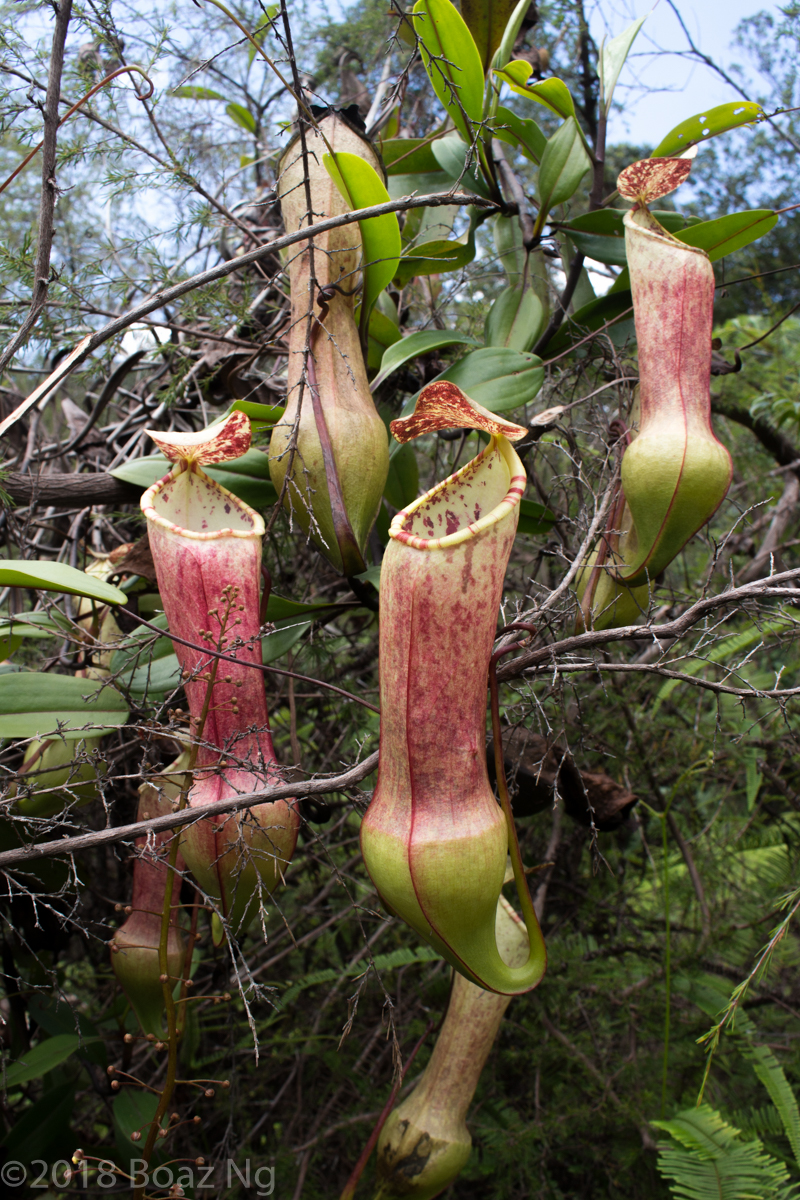 Nepenthes albomarginata, as its name suggests, has a rim of white trichomes under the peristome. The plants have an almost serpentine quality with a gracile pitcher and two fang like spines around the mouth. The plant is adapted to catch termites which graze on the rim of white trichomes. The species is associated with sandstone cliffs and, as observed, often form long swathes of vines that drape off the edge of the cliff.
Nepenthes albomarginata, as its name suggests, has a rim of white trichomes under the peristome. The plants have an almost serpentine quality with a gracile pitcher and two fang like spines around the mouth. The plant is adapted to catch termites which graze on the rim of white trichomes. The species is associated with sandstone cliffs and, as observed, often form long swathes of vines that drape off the edge of the cliff.
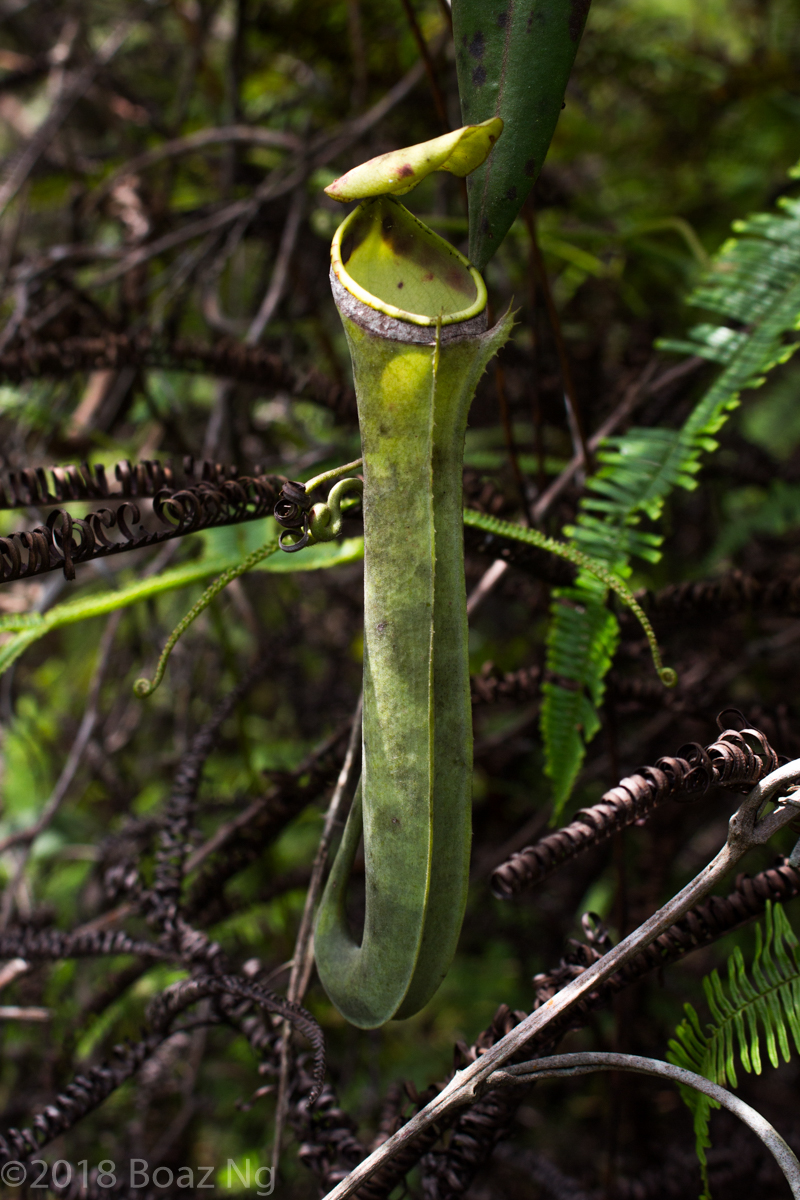 Having the privilege to see four individual species in the span of a few hours was an amazing experience. Of course, full credit must go to the locals who work hard to protect these amazing clifftop habitats and preserve their biological treasures in a country that is being deforested at alarming rates. By supporting these villagers, tourists can send a message that these environments are worthy of protection both for their biodiversity and as a source of income. With another 5 species in West Sumatra, it was time to continue my journey across the Trans-Sumatran highway towards North Sumatra!
Having the privilege to see four individual species in the span of a few hours was an amazing experience. Of course, full credit must go to the locals who work hard to protect these amazing clifftop habitats and preserve their biological treasures in a country that is being deforested at alarming rates. By supporting these villagers, tourists can send a message that these environments are worthy of protection both for their biodiversity and as a source of income. With another 5 species in West Sumatra, it was time to continue my journey across the Trans-Sumatran highway towards North Sumatra!
 The climb to the top is fairly straight forward, progressing quickly from tea plantation to deep highland rainforest to stunted cloud forest. However, as for Gunung Kerinci, its local popularity meant that the trail was heavily degraded and unfortunately devoid of Nepenthes. Perhaps I would have better luck surveying at the summit plateau? As I approached the top, thunderous clouds suddenly enveloped us and unleashed a torrent of rain. Nonetheless I spent a good hour bashing through the Pandanus and stunted bushes to try and sight some of these plants that I had climbed a whole mountain for. Alas, the thick fog obscured any trace of Nepenthes that day and I returned from the mountain soaking wet and miserable. Oh well, third time lucky?
Batang Palupuh
My gloom was quickly eclipsed by excitement as I learned that two _Rafflesia arnoldii _blooms had been located in Batang Palupuh Nature Reserve near the regional tourist center of Bukittinggi. Whilst not carnivorous, these parasitic plants emerge from its host vine to form the largest bloom in the world – reaching over 1 m in diameter. We met our local guide, a villager who searches deep into the rainforest to find these blooms, and with intrepid excitement set out into the virgin rainforest. After a short walk through the sticky jungle (sometimes the flowers can be located 2 hours away) we sighted the flowers. Perched on the side of a steep gully above a waterfall were two beautiful gigantic Rafflesia blooms.
The climb to the top is fairly straight forward, progressing quickly from tea plantation to deep highland rainforest to stunted cloud forest. However, as for Gunung Kerinci, its local popularity meant that the trail was heavily degraded and unfortunately devoid of Nepenthes. Perhaps I would have better luck surveying at the summit plateau? As I approached the top, thunderous clouds suddenly enveloped us and unleashed a torrent of rain. Nonetheless I spent a good hour bashing through the Pandanus and stunted bushes to try and sight some of these plants that I had climbed a whole mountain for. Alas, the thick fog obscured any trace of Nepenthes that day and I returned from the mountain soaking wet and miserable. Oh well, third time lucky?
Batang Palupuh
My gloom was quickly eclipsed by excitement as I learned that two _Rafflesia arnoldii _blooms had been located in Batang Palupuh Nature Reserve near the regional tourist center of Bukittinggi. Whilst not carnivorous, these parasitic plants emerge from its host vine to form the largest bloom in the world – reaching over 1 m in diameter. We met our local guide, a villager who searches deep into the rainforest to find these blooms, and with intrepid excitement set out into the virgin rainforest. After a short walk through the sticky jungle (sometimes the flowers can be located 2 hours away) we sighted the flowers. Perched on the side of a steep gully above a waterfall were two beautiful gigantic Rafflesia blooms.
 I had always assumed that I when I finally saw these plants, that they would be hidden behind a fence to prevent touchy tourists like me accidentally damaging them. But luckily for me I was in somewhat unregulated Indonesia and I quickly jumped at the opportunity to get up close and personal with them. The flowers are well known for their stench, which I found to be greatly exaggerated by popular science journalists who have never actually smelled it. For the molecular biologists out there, the scent can accurately be described as a faint waft of TEMED (imagine a perfume of ammonia and sulfur). This scent was enough to attract a hoard of flies which serve as the plants pollinator.
The texture of the leaves is dry and rubbery like a yoga mat. Intricate patterns of dots line the entire plant. In the end I spent so much time harassing the flowers and playing photoshoot that the local guide got bored and left.
I had always assumed that I when I finally saw these plants, that they would be hidden behind a fence to prevent touchy tourists like me accidentally damaging them. But luckily for me I was in somewhat unregulated Indonesia and I quickly jumped at the opportunity to get up close and personal with them. The flowers are well known for their stench, which I found to be greatly exaggerated by popular science journalists who have never actually smelled it. For the molecular biologists out there, the scent can accurately be described as a faint waft of TEMED (imagine a perfume of ammonia and sulfur). This scent was enough to attract a hoard of flies which serve as the plants pollinator.
The texture of the leaves is dry and rubbery like a yoga mat. Intricate patterns of dots line the entire plant. In the end I spent so much time harassing the flowers and playing photoshoot that the local guide got bored and left.
 Having checked off another species on my plant bucket list, I skipped elatedly back to town to wash the dirt off my body. On the way back I spotted what appears to be Nepenthes reinwardtiana hanging high off the cliffs above the rice paddies. Overall, it was an extremely rewarding day!
Harau Valley
An hour or so away from Bukittinggi is a scenic region known as the Harau Valley. Here, steep sandstone cliffs rise abruptly out of the lowland rice paddies to form one of the most beautiful regions of West Sumatra. Moderated by the cold mountainous air towards the west and the hot drafts of the Riau plains, the area has a pleasant climate that supports an accessible host of lowland Nepenthes species. Whilst the valley flats have long been cleared for agriculture, the sandstone plateaus provide an (almost) inaccessible sanctuary for many lowland species. I stayed at the famous tourist abode, Abdi Homestay, where the owner connected me with his father – a champion of conservation and plant enthusiast himself.
Having checked off another species on my plant bucket list, I skipped elatedly back to town to wash the dirt off my body. On the way back I spotted what appears to be Nepenthes reinwardtiana hanging high off the cliffs above the rice paddies. Overall, it was an extremely rewarding day!
Harau Valley
An hour or so away from Bukittinggi is a scenic region known as the Harau Valley. Here, steep sandstone cliffs rise abruptly out of the lowland rice paddies to form one of the most beautiful regions of West Sumatra. Moderated by the cold mountainous air towards the west and the hot drafts of the Riau plains, the area has a pleasant climate that supports an accessible host of lowland Nepenthes species. Whilst the valley flats have long been cleared for agriculture, the sandstone plateaus provide an (almost) inaccessible sanctuary for many lowland species. I stayed at the famous tourist abode, Abdi Homestay, where the owner connected me with his father – a champion of conservation and plant enthusiast himself.
 The next day we set off to climb these cliffs. My guide led me up a gully carved over thousands of years by water and the only way to reach the top of these cliffs. After slipping endless times over the mud and smooth rock (how the locals navigate these areas only in flip-flops amazes me), we finally reached the source of the water. As the gully narrowed into a deep chasm I suddenly realised that I was surrounded by the most beautiful botanical sight that I had ever seen!
The next day we set off to climb these cliffs. My guide led me up a gully carved over thousands of years by water and the only way to reach the top of these cliffs. After slipping endless times over the mud and smooth rock (how the locals navigate these areas only in flip-flops amazes me), we finally reached the source of the water. As the gully narrowed into a deep chasm I suddenly realised that I was surrounded by the most beautiful botanical sight that I had ever seen!
 Around me were swathes of Nepenthes ampullaria vines hanging down and across the gully. Each vine sprouted thousands of beautiful lime green pitchers, each rimmed with a bright red peristome. It was as if I entered a house of mirrors with an endless sea of pitchers engulfing me.
Around me were swathes of Nepenthes ampullaria vines hanging down and across the gully. Each vine sprouted thousands of beautiful lime green pitchers, each rimmed with a bright red peristome. It was as if I entered a house of mirrors with an endless sea of pitchers engulfing me.
 After spending ages admiring the site, my patient guide moved me onward. I was surprised to find that the top of the sandstone cliffs were vast habitats complete with fields, streams and rainforest. As we trekked deeper into the jungle, the ground started getting wetter and wetter until it turned into a rainforest swamp. This habitat is characterised by saturated soils, a shaded canopy and of course, Nepenthes ampullariaand Nepenthes gracilis!
After spending ages admiring the site, my patient guide moved me onward. I was surprised to find that the top of the sandstone cliffs were vast habitats complete with fields, streams and rainforest. As we trekked deeper into the jungle, the ground started getting wetter and wetter until it turned into a rainforest swamp. This habitat is characterised by saturated soils, a shaded canopy and of course, Nepenthes ampullariaand Nepenthes gracilis!
 Indeed, the entire swamp was covered in these two species. Massive vines reached high into the canopy whilst basal rosettes littered the forest floor. The Nepenthes ampullaria in this area was different to the gully habitat – they were quite large, finely speckled with a green peristome. This species is known for its peculiar habit of rarely forming upper pitchers. Rather, rosettes of basal growth regularly sprout along the thick vines.
Indeed, the entire swamp was covered in these two species. Massive vines reached high into the canopy whilst basal rosettes littered the forest floor. The Nepenthes ampullaria in this area was different to the gully habitat – they were quite large, finely speckled with a green peristome. This species is known for its peculiar habit of rarely forming upper pitchers. Rather, rosettes of basal growth regularly sprout along the thick vines.
 Its cousin Nepenthes gracilis shares amazingly similar growth habits. Both species prefer swampy undergrowth, are often sympatric with each other, form tight rosettes of basal pitchers and can send vines high above. What’s different is their trapping adaptations. Whilst the open pitchers of Nepenthes ampullaria are designed to trap leaf litter (earning them a detritivorous reputation), the elongated shape of Nepenthes gracilis is adapted for trapping ants. In the frequent tropical storms, ants shelter below the lid of the pitchers. A falling raindrop hits the lid from above, knocking the ant into digestive soup below.
Its cousin Nepenthes gracilis shares amazingly similar growth habits. Both species prefer swampy undergrowth, are often sympatric with each other, form tight rosettes of basal pitchers and can send vines high above. What’s different is their trapping adaptations. Whilst the open pitchers of Nepenthes ampullaria are designed to trap leaf litter (earning them a detritivorous reputation), the elongated shape of Nepenthes gracilis is adapted for trapping ants. In the frequent tropical storms, ants shelter below the lid of the pitchers. A falling raindrop hits the lid from above, knocking the ant into digestive soup below.
 Moving on from the mosquito infested rainforest depression (DEET becomes your best friend in tropical Asia) we exited to find ourselves in the exposed hills that perch above the edge of the cliffs. The habitat change is sudden – on my right was a thick impenetrable wall of rainforest growth, on my left was dry and dull scrub of almost Mediterranean quality. Adapted to the sunny sandstone substrates were the lovely Nepenthes eustachya and Nepenthes albomarginata.
The pitchers of the endemic Nepenthes eustachya have a bulbous base that tapers abruptly into a cylindrical neck. They are messily coloured, transitioning from green to pink to white with splotches of red on the lid. The species form thick vines that blanket the surrounding vegetation to get as much light as possible.
Moving on from the mosquito infested rainforest depression (DEET becomes your best friend in tropical Asia) we exited to find ourselves in the exposed hills that perch above the edge of the cliffs. The habitat change is sudden – on my right was a thick impenetrable wall of rainforest growth, on my left was dry and dull scrub of almost Mediterranean quality. Adapted to the sunny sandstone substrates were the lovely Nepenthes eustachya and Nepenthes albomarginata.
The pitchers of the endemic Nepenthes eustachya have a bulbous base that tapers abruptly into a cylindrical neck. They are messily coloured, transitioning from green to pink to white with splotches of red on the lid. The species form thick vines that blanket the surrounding vegetation to get as much light as possible.
 Nepenthes albomarginata, as its name suggests, has a rim of white trichomes under the peristome. The plants have an almost serpentine quality with a gracile pitcher and two fang like spines around the mouth. The plant is adapted to catch termites which graze on the rim of white trichomes. The species is associated with sandstone cliffs and, as observed, often form long swathes of vines that drape off the edge of the cliff.
Nepenthes albomarginata, as its name suggests, has a rim of white trichomes under the peristome. The plants have an almost serpentine quality with a gracile pitcher and two fang like spines around the mouth. The plant is adapted to catch termites which graze on the rim of white trichomes. The species is associated with sandstone cliffs and, as observed, often form long swathes of vines that drape off the edge of the cliff.
 Having the privilege to see four individual species in the span of a few hours was an amazing experience. Of course, full credit must go to the locals who work hard to protect these amazing clifftop habitats and preserve their biological treasures in a country that is being deforested at alarming rates. By supporting these villagers, tourists can send a message that these environments are worthy of protection both for their biodiversity and as a source of income. With another 5 species in West Sumatra, it was time to continue my journey across the Trans-Sumatran highway towards North Sumatra!
Having the privilege to see four individual species in the span of a few hours was an amazing experience. Of course, full credit must go to the locals who work hard to protect these amazing clifftop habitats and preserve their biological treasures in a country that is being deforested at alarming rates. By supporting these villagers, tourists can send a message that these environments are worthy of protection both for their biodiversity and as a source of income. With another 5 species in West Sumatra, it was time to continue my journey across the Trans-Sumatran highway towards North Sumatra! 
